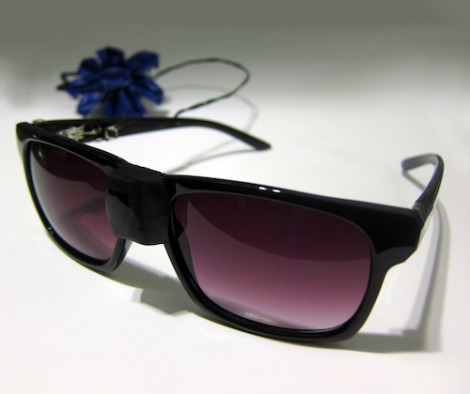
Tired of those awful sunburns? [Nikko Knappe’s] UV sensing glasses will warn you before you become crisp and red as a lobster. The bump added to the bridge support hides a TSL230R light frequency sensor. The device automatically switches on when the arms are unfolded and starts tracking cumulative exposure. If it detects a rising UV level, or you are about to burn based on skin type, an LED inside one arm of the frames will flash to inform you.
This has some potential if you think David Brin’s Earth outlines how climate change is really going to play out. Either way it’s still fun and we give bonus points to [Nikko] for disguising the lilypad that controls this as a flowery hair-pin.
















Yay! Go Ra-Boys!
Wow… interesting concept, but he definitely has a ways to go on this, namely loosing the external control module.
Peril-sensitive sunglasses?
WOuld be better with a buzzer. For suntanning. Because a flashing light won’t do anything for someone that is asleep.
That’s a good idea indeed.
Good idea, but I was wondering how wearing a hat would affect the U.V. readings?
My transitions lenses already:
1. tell me when UV light is present
2. don’t have a silly looking bump on them
3. make me look like a pedophile
Not only win-win, but win-win-win.
Jeff. Yes. Hahahaha. You’re my hero.
Too bad the Spectral Response is 350nm-1000nm, and her filter is for 320+.
Her detector is completely blind to half the UVA spectrum, UVB, and UVC. That makes it worthless.
Folks? Wear sun protection. You don’t need to worry about exposure levels if you’re covered. Find a hat you like, sunglasses with full UV protection, wear long-sleeve pants and shirt (look on the hiking clothing sites, there’s really lightweight stuff available) if you don’t like sunscreen (sunscreen is bad for the environment, especially marine life.)
Considering 98%+ of natural UV light is UVA, this will probably do just fine estimating UVB/C exposure.
Just don’t use it as a timer when you are standing in the germicidal booth at work.
“As a photodiode, it is sensitive to wavelengths equal to or shorter than the predominant wavelength it emits.”
So shouldn’t a UVA LED detect UVA, UVB and UVC?
Nah, difficult thing. Clever concept, thats granted. However, I see the problem that the sensors orientation will only see reflected light. You could be sitting on the beach with no cover or under an umbrella. It wouldn’t affect the readings. I think a hat would be better, because it has proper orientation, can contain the electronics, and even provides protection! WIN!
>So shouldn’t a UVA LED detect UVA, UVB and UVC?
Theoretically, but most likely the plastic housing will not be transparent to these wavelengths. My UVC LEDs here have air or glass cover, as well as the UVC sensors around.
Neat idea!
A great addition to out-door nerd wear would be a hat divided into 4 solar-paneled sections with a MC. Mount the bill on a motor so the bill spins to face the sun at all times and keeps you from burning.
@Bill – awesome H2G2 reference
Thanks. Didn’t have buzzer, so I used rgb-leds i had. The sensor is responsive for 320nm – 1050nm range and filter somewhere near <400nm, so it's covering almost for whole UVA range (315-400). This project was only a prototype based on my concept, and measurements are in the end somewhat empirical due to filter letting some visible and IR light passing trough and since some composition changes on UV due to sun angle (the percentage of UVB is not constant). Would like to implement these with more suitable sensor and with all components build inside the sunglass materials.
I find it difficult to believe your average geek would spend that long outdoors let alone in direct sunlight sunlight ;-)
Granted, I may not be average, but I am a geek who happens to work outdoors. A device that was built into a set of safety glasses(required by most construction jobs insurance)that let you know when you need to take a break from UV exposure(or reapply sunscreen) would be a great item. When you work hard in 85+ degree temps and high humidity levels…long sleeves are not an option.
I see lots of guys flocking to this.
I have a better idea. Apply sun screen.
cool. but, what if you fall asleep in the sun? you won’t see the LED.
Speaking of long sleeves in the summer: I’ve seen a TON of migrant farmworkers in the 100 degree cali sun, wearing long-sleeved flannel shirts.
I’d just soak mine down with water first.
I like the idea! I am trying to do something very similiar with the sensor and the lilypad but involving a jacket. I am having a problem with programming the Lilypad and the sensor together. I have the program verified and uploaded but the sensor is only returning the same value over and over again. suggesions?